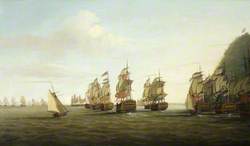How you can use this image
This image can be used for non-commercial research or private study purposes, and other UK exceptions to copyright permitted to users based in the United Kingdom under the Copyright, Designs and Patents Act 1988, as amended and revised. Any other type of use will need to be cleared with the rights holder(s).
Review the copyright credit lines that are located underneath the image, as these indicate who manages the copyright (©) within the artwork, and the photographic rights within the image.
The collection that owns the artwork may have more information on their own website about permitted uses and image licensing options.
Review our guidance pages which explain how you can reuse images, how to credit an image and how to find images in the public domain or with a Creative Commons licence available.
Notes
Add or edit a note on this artwork that only you can see. You can find notes again by going to the ‘Notes’ section of your account.
During the American War of Independence, 1775–1783, the British decided to establish a post on the east side of the entrance to the Penobscot River in Maine. On 16 June 1779 a detachment of 650 troops commanded by Colonels McLean and Campbell arrived by sea from Halifax and began clearing the ground to build a fort on a promontory by the mouth of the river. Before the fortifications had been completed the rebel Commodore Dudley Saltonstall laid siege to the British on July 25 with a fleet consisting of a frigate, 16 sloops and 24 transports. A British relief force consisting of a ship of the line, two frigates and three sloops, commanded by Sir George Collier left New York on August 3 and arrived in Penobscot Bay on the evening of the 13 August. He found Saltonstall’s men-of-war anchored in a crescent across the mouth of the river, the transports behind them. The next morning the British squadron approached them and the whole fleet retired up the river where they were pursued by Collier’s ships, aided by the three sloops which had convoyed the troops from Halifax. Saltonstall’s entire fleet was burned and two associated ships, the ‘Defence’ and ‘Hunter’ were also dealt with. The ‘Defence’ was blown up by her crew and the ‘Hunter’ was captured.
Title
Destruction of the American Fleet at Penobscot Bay, 14 August 1779
Date
late 18th C
Medium
oil on canvas
Measurements
H 101.6 x W 152.4 cm
Accession number
BHC0425
Work type
Painting








